CA4PRS: Training On-Demand
slide 1
Project Update Online for CA4PRS Software Training Development
View the PDF
Version [4 MB]
![]() You will need the Adobe
Reader to view the PDFs on this page.
You will need the Adobe
Reader to view the PDFs on this page.
![]()
slide notes
None.
slide 2
Highways need rehabilitation

![]()
slide notes
- Highways Need Renewal
- Interstates & state highways reached their design life
- DOTs shift their focus to highway sustainability (4-R)
- 1,400 Caltrans Projects ('00-'08): 50% are M&R
- Combine with Capacity increase (Widening)
- More work-zones and lane closure
- Adverse WZ Impacts
- Impacts travelers, communities, businesses
- Mobility: Responsible for 12% of delay
- Safety: 40,000 injuries, 1028 fatalities in CWZ (2003)
- Improve WZ Mobility and Enhance Safety
slide 3
Some challenges identified...
- Longer-lasting Design
- Faster Construction delivery
- Tolerable Work Zone traffic delays
- Agency Budget constraints
![]()
slide notes
- Adverse WZ Impacts
- Impacts travelers, communities, businesses
- Mobility: Responsible for 12% of delay
- Safety: 40,000 injuries, 1028 fatalities in CWZ (2003)
- Improve WZ Mobility and Enhance Safety
slide 4
CA4PRS: Decision Support Tool
Help agencies and contractors to select more efficient and economic highway construction strategies

- Construction Schedule
- Traffic Delay
- Agency Cost
![]()
slide notes
Modeling started in 1998, with version 1.0 of the software complete in 2002. Validation and use began in 2003 and enhancements have continued since. Now on version 2.5, which includes many additional rehabilitation strategies and analysis modules. FHWA has got involved as well and made the software available to states via AASHTO.
- FHWA pooled fund for SPTC (CA, FL, MN, TX, WA), developed by UC Berkeley ITS (since 1998: $2M)
- Caltrans 'Standard' and FHWA endorsed 'Technology'
- FHWA/AASHTO Free-group License for 50 DOTs
slide 5
Project Goal & Objectives
- Educate agency personnel and consultants CA4PRS use and its benefits
- Increase availability of CA4PRS training
- Provide consistent training anytime, any place
- Reduce training time for required participants
- Reduce overall cost of training program
![]()
slide notes
- Educate agency personnel and consultants in road construction on CA4PRS use and its benefits
- Increase the availability of CA4PRS training beyond the classroom
- Provide consistent anytime, anyplace training to individuals regardless of location
- Reduce required participant training time to achieve program learning objectives
- Reduce overall cost of training program delivery for stakeholders and participants
slide 6
Why online training?
- About 50% more time efficient without loss of effectiveness
- Repetition leads to retention
- Consistent message delivered
- Easily updateable and instantly distributed
- Assessments, Tracking, and Reporting
- Cost benefit compared to classroom delivery
![]()
slide notes
- What is the largest university in the world?
slide 7
E-learning savings vs. ILT
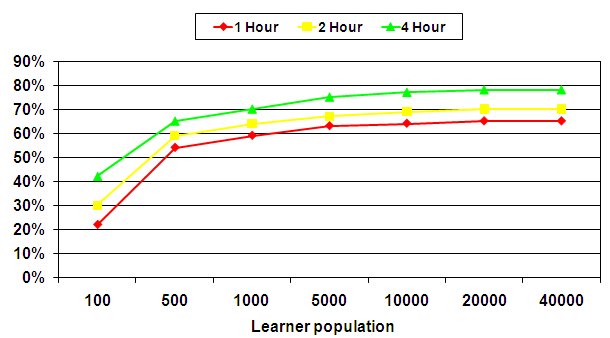
Source: Caterpillar (http://www.astd.org/LC/2005/0605_walliker.htm
![]()
slide notes
None.
slide 8
Scope of Services
- A 2-3 day in-class seminar is about the same as 6 classroom equivalent hours online.
![]()
slide notes
None.
slide 9
Program Elements
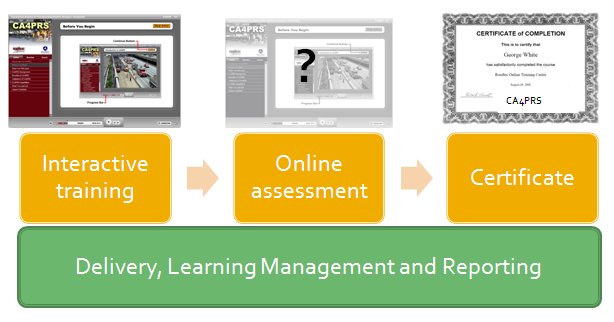
![]()
slide notes
- Interactive training. Online, self paced training lessons containing interactions, animations, videos, and graphics to illustrate concepts and meet learning objectives.
- Online assessment. Following the training course, exercises and an assessment will be delivered to measure retention of participants and effectiveness of training program.
- Certification. Following successful completion of the training course, participants will receive a personalized certificate that demonstrates proficiency on the topic.
- Delivery, Learning Management, and Reporting. Administrative account for WSDOT to monitor and report on participant progress and performance of training program directly from the web.
slide 10
Course development process
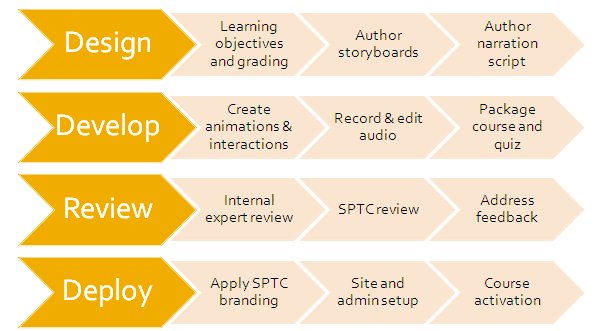
![]()
slide notes
We could show status by potentially graying out what has been completed or vice versa.
Schedule from SOW: The following work flow and schedule assumes a March 1st start date and a February 1st 2011 completion date. The following deliverables and completion dates are anticipated for each of the tasks:
2010
- Mar-Jun: Task A. Design
- Course learning objectives and outline for each module
- Storyboard for each module ready for production
- Narration script for each module ready for production
- Jul-Oct: Task B. Develop
- Web-ready version of course packaged for review
- Nov-Dec: Task C. Review
- Web-ready version of course packaged with review comments addressed
- Jan: Task D. Deploy
- Customized web-based training interface activated for CA4PRS course and participants as per OTC hosting plan
- Course content packaged and available in SCORM compliant format
2011-2013
- Feb-Jan: Task E. Delivery
- CA4PRS training is available for up to 2,000 SPTC member users (1,000 per year over 2 years) via OTC hosting plan
slide 11
CA4PRS Online Training Program
- Introduction [0.5 hr]
- Schedule Analysis [2.5 hr]
- Work Zone Traffic [1.0 hr]
- Project Cost Estimate [1.0 hr]
- Implementation and Exercises [1.0 hr]
![]()
slide notes
The scope of this statement of work involves reducing the current 2-3 day in-class seminar into an approximately 6 classroom equivalent hours of online training. Based on evaluation of the existing course and content provided, when fully complete, it is anticipated the course will contain the following self-paced modules (module length in classroom equivalent hours):
- Introduction [1 hour]
- Schedule Analysis [2.5 hours, 30 minutes each topic below]
- JPCP
- Milling/AC
- Crack and Seat & FDAC
- CRCP
- Precast Concrete*
- Roadway Widening**
- Work Zone Traffic [1 hour]
- Lane closures
- Work Zone capacity and sensitivity
- Project Cost Estimate [1 hour]
- Agency Cost
- Traffic Costs
- Present Value
- Implementation and Exercises [30 minutes]
*Anticipated to be developed following v2.5 release in March
**Anticipated to be developed following v3.0 release in November
slide 12
CA4PRS Online Training Program
- Introduction
- Schedule Analysis
- Introduction
- JPCP
- Milling/AC
- Crack and Seat/FDAC
- CRCP
- Precast Concrete
- Roadway Widening*
*Anticipated to be developed following v 3.0 release in November 2010
![]()
slide notes
The scope of this statement of work involves reducing the current 2-3 day in-class seminar into an approximately 6 classroom equivalent hours of online training. Based on evaluation of the existing course and content provided, when fully complete, it is anticipated the course will contain the following self-paced modules (module length in classroom equivalent hours):
- Introduction [1 hour]
- Schedule Analysis [2.5 hours, 30 minutes each topic below]
- JPCP
- Milling/AC
- Crack and Seat & FDAC
- CRCP
- Precast Concrete*
- Roadway Widening**
- Work Zone Traffic [1 hour]
- Lane closures
- Work Zone capacity and sensitivity
- Project Cost Estimate [1 hour]
- Agency Cost
- Traffic Costs
- Present Value
- Implementation and Exercises [30 minutes]
*Anticipated to be developed following v2.5 release in March
**Anticipated to be developed following v3.0 release in November
slide 13
CA4PRS Online Training Program
- Work Zone Traffic
- Lane closures
- Work zone capacity and sensitivity
- Project Cost Estimate
- Agency Cost
- Traffic Costs
- Present Value
![]()
slide notes
The scope of this statement of work involves reducing the current 2-3 day in-class seminar into an approximately 6 classroom equivalent hours of online training. Based on evaluation of the existing course and content provided, when fully complete, it is anticipated the course will contain the following self-paced modules (module length in classroom equivalent hours):
- Introduction [1 hour]
- Schedule Analysis [2.5 hours, 30 minutes each topic below]
- JPCP
- Milling/AC
- Crack and Seat & FDAC
- CRCP
- Precast Concrete*
- Roadway Widening**
- Work Zone Traffic [1 hour]
- Lane closures
- Work Zone capacity and sensitivity
- Project Cost Estimate [1 hour]
- Agency Cost
- Traffic Costs
- Present Value
- Implementation and Exercises [30 minutes]
*Anticipated to be developed following v2.5 release in March
**Anticipated to be developed following v3.0 release in November
slide 14
Demonstration: JPCP
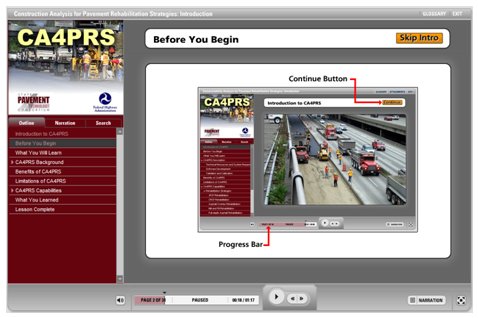
![]()
slide notes
None.
slide 15
Schedule and Timeline
- 2010
- Design
- Develop
- Review
- Deploy
- 2011 – 2013
- Delivery
![]()
slide notes
None.
slide 16
Deliverables and Delivery Details
- Available early 2011:
- Web-based training modules and content available
- Delivery provided for up to 2,000 users (1,000/year) till end of 2013
- Admin and reporting tools via Pavia Systems hosted Learning Management System
![]()
slide notes
Deliver CA4PRS training course to WSDOT and SPTC member agencies (Caltrans, MnDOT, TxDOT), and provide limited access to other state DOT's. This involves the following:
- Pavia Systems will deliver the web-based CA4PRS training course via their hosted OTC.
- Delivery service for up to 2,000 individuals (@ 1,000 individuals per year over 2 years) for WSDOT and SPTC member agencies (WSDOT and Pavia Systems will discuss service options for additional users outside of the SPTC)
- Non-SPTC state DOT's will be provided access to courseware as per option determined above
- Provide trainee tracking, content management, and course management functions to WSDOT
- Implement long-term support and delivery plan for the online course. It is envisioned that WSDOT will select one of the following options:
- Continue using Pavia Systems' OTC for hosting, delivery and maintenance of CA4PRS training course and user management features (no WSDOT server requirements or issues) at appropriate service plan
- Discontinue use of Pavia Systems' OTC and deploy the training in a manner of their choosing using provided SCORM packaged course
slide 17
Course development process
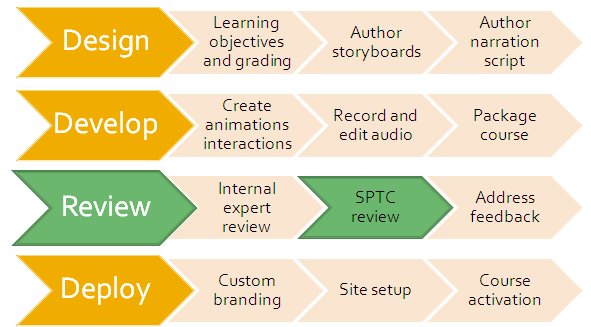
![]()
slide notes
We could show status by potentially graying out what has been completed or vice versa.
Schedule from SOW: The following work flow and schedule assumes a March 1st start date and a February 1st 2011 completion date. The following deliverables and completion dates are anticipated for each of the tasks:
- 2010
- Mar-Jun: Task A. Design
- Course learning objectives and outline for each module
- Storyboard for each module ready for production
- Narration script for each module ready for production
- Jul-Oct: Task B. Develop
- Web-ready version of course packaged for review
- Nov-Dec: Task C. Review
- Web-ready version of course packaged with review comments addressed
- January: Task D. Deploy
- Customized web-based training interface activated for CA4PRS course and participants as per OTC hosting plan
- Course content packaged and available in SCORM compliant format
- Mar-Jun: Task A. Design
- 2011-2013
- Feb-Jan: Task E. Delivery
- CA4PRS training is available for up to 2,000 SPTC member users (1,000 per year over 2 years) via OTC hosting plan
- Feb-Jan: Task E. Delivery
slide 18
Want to review or test drive?
- Review periods will occur throughout the year on individual modules
- Interested in providing feedback during review contact:
- George White
- george@paviasystems.com
- 206.428.3094 x4
![]()
slide notes
None.
slide 19
Some other updates...
- Pavement Interactive
- Free Training Resources
- RAP
- Warm Mix
- Sustainability
- Rubberized HMA
![]()
slide notes
None.
slide 20
Pavement Interactive
- Looking for a just-in-time resource on pavement practices?
- Seeking a free, credible resource for pavement needs?
- In search of graphics, videos, and animations to help with pavement education?
| Core Modules |
|---|
|
![]()
slide notes
None.
slide 21
Who is involved?

![]()
slide notes
None.
slide 22
Who uses it?
Over 320,000 unique visitors
With over 3,000,000 page views
From over 220 countries
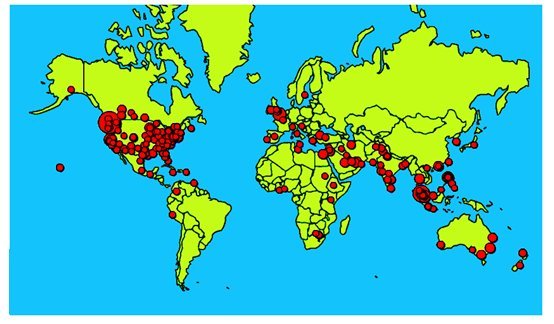
![]()
slide notes
None.
slide 23
Latest developments...
- New content added
- LCCA
- Asphalt Additives
- DBR Construction
- BST
- Sustainability
- Permeable/Porous Pavements
- Survey and poll
![]()
slide notes
None.
slide 24
Available for access now!
http://www.pavementinteractive.org![]()
slide notes
None.
slide 25
Free Introductory Modules
- Warm Mix Asphalt
- Reclaimed Asphalt Pavement
- Rubberized Hot Mix Asphalt
- Sustainability and Paving
![]()
slide notes
None.
slide 26
Warm Mix Asphalt (WMA)
- With the Warm Mix module, in 15 minutes you'll get answers to questions like:
- Is Warm Mix cheaper, safer, or higher quality?
- What are the Warm Mix production approaches?
- Are there any risks to using Warm Mix?
![]()
slide notes
None.
slide 27
Reclaimed Asphalt Pavement (RAP)
- With the RAP module, you'll get answers to questions like:
- How long has RAP been used in the field?
- Is RAP cheaper, safer, or produce higher quality when compared to virgin materials?
- What are the risks to using RAP?
![]()
slide notes
None.
slide 28
Rubberized Hot Mix Asphalt (RHMA)
- In less than 15 minutes you'll be introduced to:
- How rubberized hot mix asphalt was developed
- Production and mix design processes for RHMA
- Applications of RHMA
- Proper RHMA paving techniques
![]()
slide notes
None.
slide 29
Sustainability and Paving
- The free Sustainability and Paving course discusses:
- What sustainability means for asphalt paving & why it matters for your business
- How to define sustainability for our industry
- Examples of sustainable practices used today
![]()
slide notes
None.
slide 30
Available for free distribution now!
http://www.paviasystems.com/freearchive
![]()
slide notes
None.
slide 31
Questions?
- Want to know more about freely available resources for the industry?
- Have a request for the next intro topic?
- Got other ideas to share?
George White
george@paviasystems.com
206.428.3094 x4
![]()
slide notes
None.